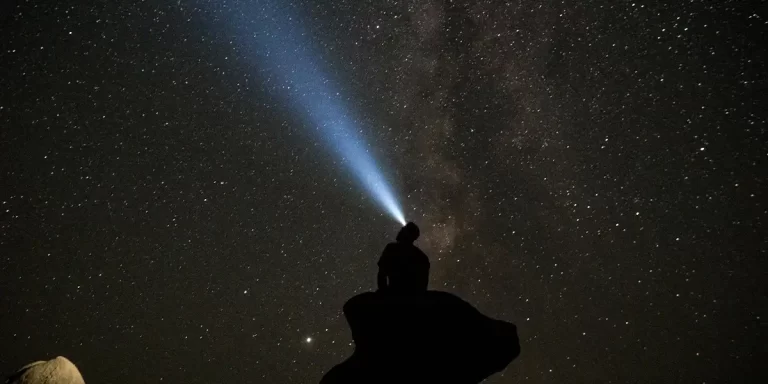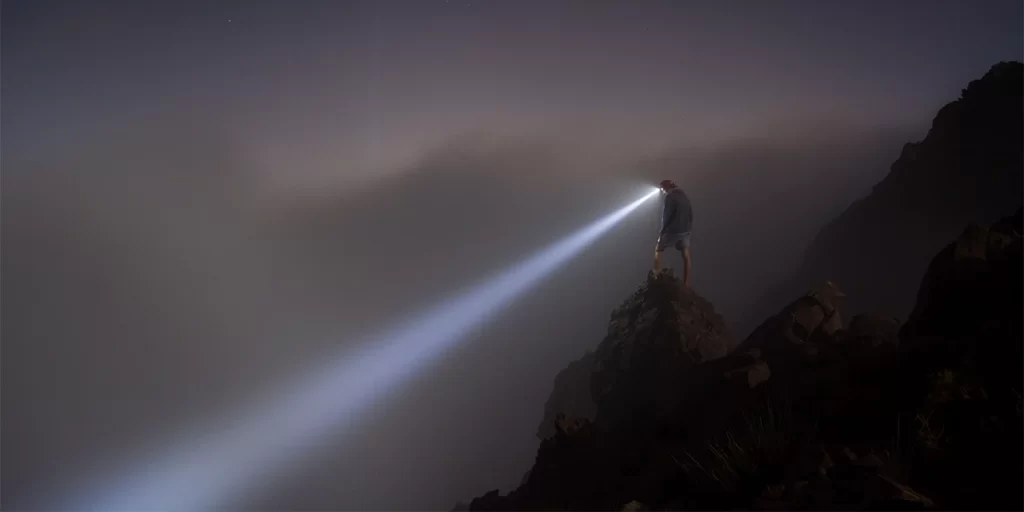

Whether you’re an adventurous night hiker or just setting up camp after sunset, one thing becomes crystal clear – you need a reliable hiking light.
In this post, we’ll shed light (pun intended) on the age old debate: flashlight vs headlamp. By the time we’re done, you’ll have a clear picture of which one is the right hiking light for you.
Interested? Let’s get started.

The invention of the flashlight in 1898 revolutionized personal illumination. Today’s LED flashlights are a vast improvement, providing ultra-bright light from a small power source.
Flashlight Pros:
Flashlight Cons:
Some popular lightweight or ultralight flashlight options include:
| Make / Model | Weight (g) |
|---|---|
| Nitecore TIP 2 | 1.34 oz (38) |
| RovyVon Aurora A3x | 0.69 oz (19.5) |
| Fenix E12 V2.0 | 1.80 oz (51) |
| Coast HX5 | 2.78 oz (79) |

For centuries, explorers have used crude oil lamps on their heads to light the way. Modern hikers now rely on LED headlamps for hands-free lighting on night trails.
Headlamp Pros:
Headlamp Cons:
Some popular ultralight and compact headlight options include:
| Make / Model | Weight (g) |
|---|---|
| Petzl Bindi Headlamp | 1.16 oz (33) |
| Nitecore HA11 Head Torch | 1.27 oz (36) |
| Petzl Swift RL | 3.52 oz (100) |
| Black Diamond Astro 300 Headlamp | 2.64 oz (75) |
Here’s a quick comparison table summarizing the main differences between these two options:
| Feature | Flashlight | Headlamp |
|---|---|---|
| Beam type | Narrow spot, focused | Wide flood, diffuse |
| Brightness | Up to 1000+ lumens typical | Up to 300 lumens typical |
| Beam distance | Up to 650+ feet | Up to 125 feet |
| Light modes | Multiple modes | Multiple modes |
| Battery type | AAA, AA, CR123A, lithium | AAA, AA, CR123A, lithium |
| Runtime | 0.5-48 hours depending on brightness | 2-80 hours depending on brightness |
| Weight | Similar | Similar |
| Water resistance | IPX4 splashproof to IPX8 underwater | IPX4 splashproof to IPX7 waterproof |
| Impact resistance | 1-2 meters typical | Less than 1 meter |
| LED bulb type | Cree, Osram, Philips Lumileds, Nichia | Cree, Osram, Nichia |
| Cost | $10-$100+ | $20-$200+ |
Now that we’ve covered the ins and outs of hiking lights, it’s time to focus on finding the perfect one for your outdoor adventures. So which one should you go for?
From our experience you should:
For instance, we always use a headlamp with a strong strap as our primary hiking light —it’s our preference and suits our hiking and backpacking styles.
In your quest for the perfect hiking light, you’ve unlocked the key to conquering the night. Whether you prefer the hands-free brilliance of a headlamp or the versatility of a flashlight, your choice will light up your outdoor escapades.
Remember to match your light to your needs and adventures. Prioritize power sources, weather resistance, and durability. Armed with the right light, you’re ready for any journey. Happy hiking!
Check out our TOP 5 Guides on headlamps and flashlights, where we’ve listed the lightest hiking lights available on the market.
A headlamp frees up both hands completely, making it ideal for camping, hiking, working on projects that require the use of your hands, or any activities done in low-light settings. The headlamp beam moves with your head, keeping your field of vision illuminated. Flashlights can be easily aimed and are often brighter than headlamps. They are a better choice when you need to focus a beam in a specific direction or over longer distances. Flashlights may also be preferable for short or intermittent use as they don’t require strapping a light to your head. Consider using a headlamp for prolonged use where hands-free operation is important, while a flashlight offers more flexibility for briefly directed lighting needs.
The choice between a headlamp and a flashlight depends on your needs. Headlamps offer hands-free convenience, ideal for personal use and night hiking. Flashlights provide versatility and strong beams, making them great for signaling and customization.
The number of lumens you need for a hiking headlamp depends on your hiking conditions. For general hiking, 150-300 lumens are usually sufficient. If you’re trail running or need longer-distance illumination, consider 300-600 lumens. Tailor the lumens to your specific requirements for the best hiking experience.